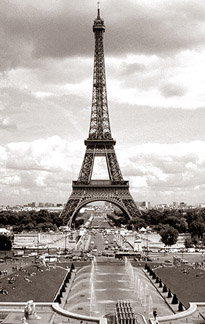|
observer |
|
|
|
|
|
OTHER LINKS |

|

|

|
The Eiffel TowerA brief history of the Eiffel TowerDesigned by Gustave Eiffel in 1889 for the Worlds Fair, the Eiffel Tower is perhaps the most recognizable structure in the world.
Despite these early grumblings, people flocked to ride the elevator nine hundred feet up to the third level observation platform. From the platform visitors could marvel at the uninterrupted vistas of Paris from every direction. In fact, so many people visited the Eiffel Tower during its first year that almost all its construction costs were covered by ticket sales. Today the Eiffel Tower stands as one of the most famous landmarks of France, attracting tourists from all over the world. The city of Paris held a competition in 1887, looking for designs for a temporary monument that would be unveiled during the 1889 Worlds Fair. The winning designer, Gustave Eiffel, designed a huge iron latticework tower as a tribute to the French Revolution. Originally the tower was slated to stand for only twenty years. Part of the rules of the design contest stated the structure could be taken down easily. However, by the twenty-year mark, in 1909, the tower was not only popular with tourists; it proved a valuable communication tool for radio broadcasting. Standing 986 feet tall, the tower is constructed of 18,000 pieces of wrought iron. Every seven years it is repainted. Three different colours are used to help give the tower a uniform look. Darker paint is used on the top, and slightly lighter paint is used on the bottom, to contrast against the lighter sky and darker ground. Because the Eiffel Tower was the tallest structure in the world at the time of its construction, Gustave Eiffel put careful consideration into how it would hold up to gusty winds. He designed the tower with open latticework of wrought iron, allowing winds to blow through the tower, rather than against it. This plan worked so well that even during the strongest winds the tower never sways more than four and half inches. By WWII, national pride in the monument that was once hailed as an eyesore was so great that when Paris fell to the Nazis, French rebels cut the cables to the elevator of the tower so Hitler would have to climb the stairs. When the Nazis hung their swastika flag from its summit, a determined Frenchman climbed up the tower and replaced it with the French flag. Despite poor acceptance during its first few years, the Eiffel Tower has been embraced by French citizens, and stands as one of the most recognizable structures in the world. Sources: www.discoverfrance.net www.wikpedia.org/wiki/Eiffel_Tower, www.pbs.org/wgbh/buildingbig/wonder/structure/eiffel_tower.html |
 When the Eiffel Tower was first constructed in 1889, many in the
artistic community of Paris signed petitions against "...the useless and
monstrous Eiffel Tower." Nature lovers worried it would disrupt the
flight of birds over Paris. People claimed it could not be completed on
time, or within its budget of 1.5 million dollars.
When the Eiffel Tower was first constructed in 1889, many in the
artistic community of Paris signed petitions against "...the useless and
monstrous Eiffel Tower." Nature lovers worried it would disrupt the
flight of birds over Paris. People claimed it could not be completed on
time, or within its budget of 1.5 million dollars. 







